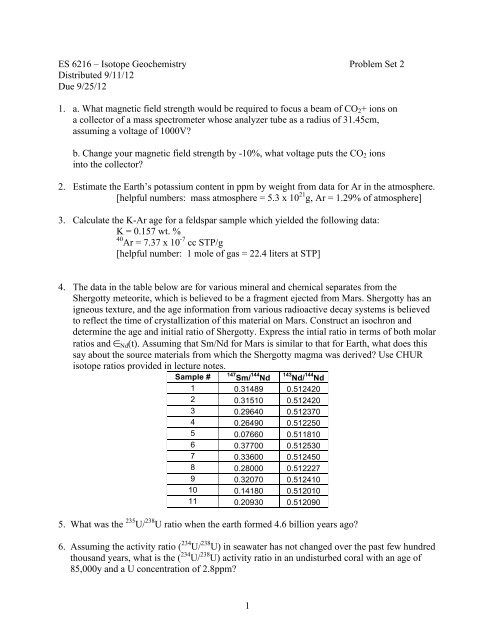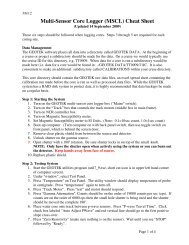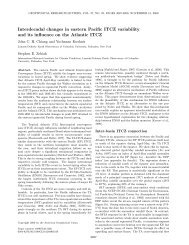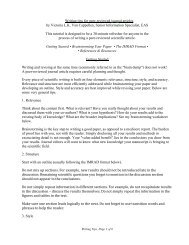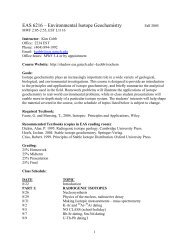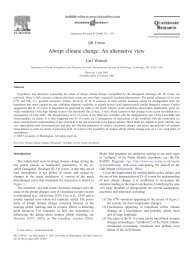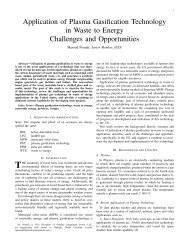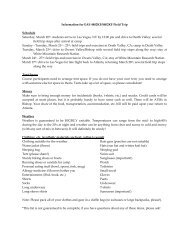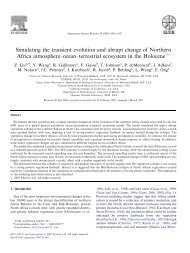1 ES 6216 â Isotope Geochemistry Problem Set 2 Distributed 9/11 ...
1 ES 6216 â Isotope Geochemistry Problem Set 2 Distributed 9/11 ...
1 ES 6216 â Isotope Geochemistry Problem Set 2 Distributed 9/11 ...
Create successful ePaper yourself
Turn your PDF publications into a flip-book with our unique Google optimized e-Paper software.
<strong>ES</strong> <strong>6216</strong> – <strong>Isotope</strong> <strong>Geochemistry</strong> <strong>Problem</strong> <strong>Set</strong> 2<br />
<strong>Distributed</strong> 9/<strong>11</strong>/12<br />
Due 9/25/12<br />
1. a. What magnetic field strength would be required to focus a beam of CO 2 + ions on<br />
a collector of a mass spectrometer whose analyzer tube as a radius of 31.45cm,<br />
assuming a voltage of 1000V?<br />
b. Change your magnetic field strength by -10%, what voltage puts the CO 2 ions<br />
into the collector?<br />
2. Estimate the Earth’s potassium content in ppm by weight from data for Ar in the atmosphere.<br />
[helpful numbers: mass atmosphere = 5.3 x 10 21 g, Ar = 1.29% of atmosphere]<br />
3. Calculate the K-Ar age for a feldspar sample which yielded the following data:<br />
K = 0.157 wt. %<br />
40 Ar = 7.37 x 10 -7 cc STP/g<br />
[helpful number: 1 mole of gas = 22.4 liters at STP]<br />
4. The data in the table below are for various mineral and chemical separates from the<br />
Shergotty meteorite, which is believed to be a fragment ejected from Mars. Shergotty has an<br />
igneous texture, and the age information from various radioactive decay systems is believed<br />
to reflect the time of crystallization of this material on Mars. Construct an isochron and<br />
determine the age and initial ratio of Shergotty. Express the intial ratio in terms of both molar<br />
ratios and ∈ Nd (t). Assuming that Sm/Nd for Mars is similar to that for Earth, what does this<br />
say about the source materials from which the Shergotty magma was derived? Use CHUR<br />
isotope ratios provided in lecture notes.<br />
Sample #<br />
147 Sm/ 144 Nd<br />
143 Nd/ 144 Nd<br />
1 0.31489 0.512420<br />
2 0.31510 0.512420<br />
3 0.29640 0.512370<br />
4 0.26490 0.512250<br />
5 0.07660 0.5<strong>11</strong>810<br />
6 0.37700 0.512530<br />
7 0.33600 0.512450<br />
8 0.28000 0.512227<br />
9 0.32070 0.512410<br />
10 0.14180 0.512010<br />
<strong>11</strong> 0.20930 0.512090<br />
5. What was the 235 U/ 238 U ratio when the earth formed 4.6 billion years ago?<br />
6. Assuming the activity ratio ( 234 U/ 238 U) in seawater has not changed over the past few hundred<br />
thousand years, what is the ( 234 U/ 238 U) activity ratio in an undisturbed coral with an age of<br />
85,000y and a U concentration of 2.8ppm?<br />
1
) Assuming that no Th was incorporated into its skeleton when it precipitated, how<br />
many 230 Th atoms does a 1g sample of this coral contain?<br />
c) The analytical precision for a U-Th age is typically limited by measurement of the<br />
230 Th atoms, and typically one is lucky to recover 0.05% of the total 230 Th atoms during<br />
a typical mass spec run. What will be a minimum 2σ relative error on the U-Th age for<br />
your 1g coral sample?<br />
7. Suppose a radioactive gaseous element in the atmosphere has a half-life of 6yrs. Its daughter,<br />
also radioactive, has a half-life of one month. Because the daughter is not gaseous, it adsorbs<br />
onto aerosol particles and is removed by physical processes, mainly precipitation. If the<br />
activity ratio for these two isotopes (daughter/parent) in the atmosphere is observed to be 0.3<br />
in steady state, what is the lifetime of the daughter with respect to physical removal from the<br />
atmosphere?<br />
8. The following activity ratios were measured in a manganese nodule. Estimate the growth rate<br />
of the nodule, assuming that the amount of U-supported 230 Th is negligible.<br />
Depth (mm)<br />
230 Th/ 232 Th<br />
0-0.3 43.7± 1.8<br />
0.3-0.5 26.2 ± 0.6<br />
0.5-0.85 10.4 ± 0.3<br />
2


